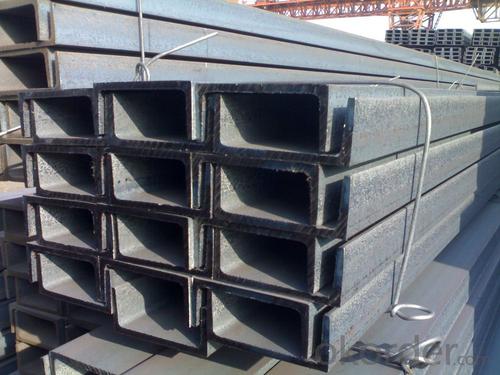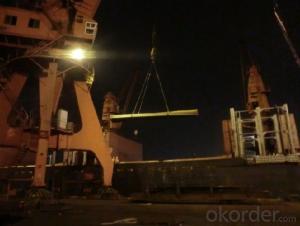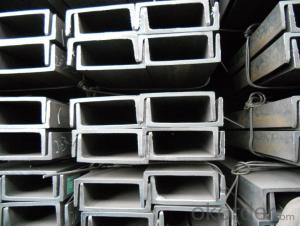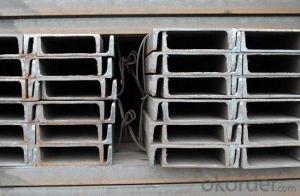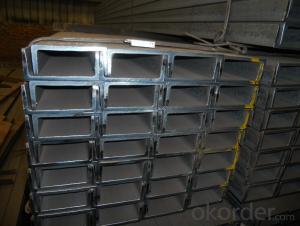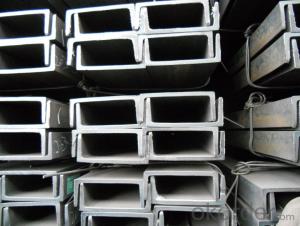High Quality Steel Channel 125mm
- Loading Port:
- China Main Port
- Payment Terms:
- TT OR LC
- Min Order Qty:
- -
- Supply Capability:
- -
OKorder Service Pledge
OKorder Financial Service
You Might Also Like
Steel Channel
Standard: JIS
Material: SS400
Length: 6m, 12m
Size:
| Size (mm) | Mass (Kg/m) |
| 125*65*5.2 | 11.66 |
| 125*65*5.5 | 12.91 |
| 125*65*6.0 | 13.40 |
Package & Delivery of Steel Channel:
1.The hot rolled channel steel will be packed in bundle with steel wire at each end of every bundle and color marking in order to help the customer to recognize his goods more easily at sight.
2. And the hot rolled channel steel could be loaded into 20ft or 40ft container, or by bulk cargo.If the weight of each bundle reaches more than 3.5 mt, the loading by break bulk cargo should be choosed.When the weight of each bundle reaches less than 3mt, the loading by container should be choosed.
3.As for the transportaion from mill to loading port, the truck will be usually used. And the maximum quantity for each truck is 40mt.
4.All in all, we could do in accordance with customer's request.
Production Flow of JIS Channel:
1.The steel billet shall be heated in the high temperature furnace.
2. The heated steel billet shall be rolled five to nine times with the aim of shaping the general figure of steel u channel.
3. The rolled steel channel should be put onto the cooling bed to make the temperature low.
4. The JIS Channel should be straighted on the straightener.
5. The straighted steel u channel will be cut into meters by saw, as per customer's requirements.
6. At the last part of production, the channel steel must be tested in order to confirm that the finished products are completely free from crack, pore, slag, scab or fold on the surface.
*If you would like to get our price, please inform us the size, standard/material and quantity. Thank you very much for your attention.
- Q: Can steel channels be used in the aerospace parts manufacturing industry?
- Indeed, the aerospace parts manufacturing industry can employ steel channels. The construction of aircraft structures and components often relies on steel channels, owing to their remarkable attributes of strength, durability, and resistance to deformation. Framing, support structures, and reinforcement for crucial aerospace parts are among the diverse applications that steel channels can fulfill. By providing structural integrity and stability, steel channels play a pivotal role in ensuring the secure and dependable operation of aerospace vehicles. Moreover, the aerospace industry benefits from the ease of fabrication and welding that steel channels offer, rendering them an excellent choice that upholds precision and quality, which are paramount in this field.
- Q: Can steel channels be used for bracing purposes?
- Yes, steel channels can be used for bracing purposes. Steel channels are often used in construction and engineering to provide structural support and reinforcement. They are commonly utilized as bracing elements in various applications, such as in the construction of buildings, bridges, and other structures. Steel channels have excellent strength and durability, making them suitable for withstanding heavy loads and providing stability. They can be used to reinforce beams, columns, walls, and other components, helping to prevent buckling, bending, or collapse. Additionally, steel channels are versatile and can be easily customized and installed to meet specific bracing requirements. Overall, steel channels are a reliable and effective choice for bracing purposes in construction and engineering projects.
- Q: How do steel channels perform under heavy loads?
- Steel channels are known for their exceptional strength and durability, making them highly capable of performing under heavy loads. The structural design of steel channels allows them to distribute and transfer the weight of heavy loads evenly, preventing any concentrated stress points that could cause failure. Additionally, steel channels have a high load-bearing capacity due to their ability to resist bending and twisting forces. This makes them ideal for supporting heavy machinery, equipment, or structures, ensuring stability and safety. Moreover, steel channels can withstand substantial compression and tension forces, making them suitable for a wide range of applications in various industries. Overall, steel channels excel in handling heavy loads by providing reliable support, stability, and load-bearing capabilities.
- Q: What are the considerations for selecting steel channel sizes?
- When selecting steel channel sizes, there are several considerations that need to be taken into account. These include the load-bearing capacity required for the intended application, the span or distance between supports, the material and weight of the items being supported, and the structural stability needed. Additionally, factors like cost, availability, and compatibility with other building materials may also influence the selection process. Ultimately, the goal is to choose a steel channel size that can effectively support the intended load while ensuring structural integrity and meeting the project's requirements.
- Q: Can steel channels be used for staircase stringers?
- Yes, steel channels can be used for staircase stringers. Steel channels are commonly used for staircase stringers due to their strength, durability, and ability to support heavy loads. They provide a sturdy and reliable framework for the stairs, ensuring stability and safety. Additionally, steel channels can be easily customized and fabricated to fit specific staircase designs and dimensions.
- Q: Are steel channels suitable for use in marine environments?
- Yes, steel channels are suitable for use in marine environments. Steel is known for its high strength and durability, making it an ideal material for marine applications. Steel channels are commonly used in the construction of ships, offshore structures, and other marine equipment. One of the main reasons why steel channels are suitable for marine environments is their resistance to corrosion. Steel can be coated with protective layers such as galvanization or epoxy paint to prevent rusting and corrosion caused by saltwater exposure. These coatings create a barrier between the steel and the corrosive elements in marine environments, prolonging the lifespan of steel channels. Additionally, steel channels offer excellent structural integrity and load-bearing capacity. They can withstand the harsh conditions of the sea, including waves, currents, and extreme weather events. Steel channels are also capable of supporting heavy loads, making them suitable for various marine applications such as shipbuilding, dock construction, and offshore platforms. Furthermore, steel channels have good fire resistance properties, which is crucial for safety in marine environments. In the event of a fire on a ship or offshore structure, steel channels can help contain the spread of flames and maintain the structural integrity of the vessel or platform. However, it is important to note that regular maintenance and inspection are necessary to ensure the ongoing suitability of steel channels in marine environments. Periodic inspections for signs of corrosion or damage and timely repairs or replacements are essential to maintain the structural integrity and safety of steel channels in marine applications. In conclusion, steel channels are indeed suitable for use in marine environments due to their high strength, corrosion resistance, load-bearing capacity, and fire resistance properties. With proper maintenance and inspection, steel channels can provide long-lasting performance in marine applications.
- Q: How do steel channels contribute to the overall sound insulation of a structure?
- Steel channels can contribute to the overall sound insulation of a structure in several ways. Firstly, steel channels are often used as framing components in walls, ceilings, and floors. They provide a rigid structure that helps to minimize vibrations and reduce the transmission of sound waves. Additionally, steel channels can be filled with insulation materials such as mineral wool or fiberglass, which further enhance their soundproofing capabilities. These insulation materials absorb sound energy and reduce its transfer through the channels, effectively increasing the sound insulation of the structure. Moreover, steel channels can be used to create double-wall or staggered stud constructions, which are known for their excellent soundproofing properties. By incorporating multiple layers of steel channels and insulation materials, these constructions create air gaps that act as sound barriers, preventing sound waves from passing through. This technique is particularly effective in reducing airborne noise, such as voices, music, or traffic sounds. Furthermore, steel channels can be used to mount resilient sound isolation clips or brackets, which help to decouple walls or ceilings from the structure. This decoupling prevents vibrations and impact noise from transferring between different areas of the building, enhancing the overall sound insulation. In summary, steel channels contribute to the overall sound insulation of a structure by providing a rigid framework, allowing for the inclusion of insulation materials, creating double-wall or staggered stud constructions, and facilitating the use of resilient sound isolation clips. By employing these techniques, steel channels help to minimize the transmission of sound waves and create a quieter and more comfortable environment within the building.
- Q: Can steel channels be used for access platforms?
- Yes, steel channels can be used for access platforms. Steel channels are commonly used in the construction of access platforms due to their strength and durability. They provide a sturdy framework for supporting and securing the platform, ensuring the safety of workers while accessing elevated areas. The versatility of steel channels allows for customization and adaptation to different platform designs and requirements. Additionally, steel channels can be easily welded or bolted together, making them a convenient choice for constructing access platforms.
- Q: How do steel channels perform in corrosive environments?
- Steel channels are generally known for their durability and strength, but their performance in corrosive environments can vary depending on the specific type of steel used and the severity of the corrosive conditions. In general, steel channels are resistant to corrosion due to their protective oxide layer that forms on the surface when exposed to oxygen in the air. This layer acts as a barrier, preventing further oxidation and protecting the steel from corrosion. However, when exposed to corrosive environments such as saltwater, acidic solutions, or industrial chemicals, the protective oxide layer can be compromised, leading to potential corrosion. The performance of steel channels in corrosive environments can be enhanced by using corrosion-resistant alloys or coatings. Stainless steel channels, for example, contain chromium and other alloying elements that provide excellent corrosion resistance. These channels are highly resistant to rust and can withstand even the most challenging environments. In more severe corrosive conditions, additional protective measures such as galvanizing or epoxy coatings can be applied to steel channels. Galvanizing involves coating the steel with a layer of zinc, which acts as a sacrificial anode, protecting the underlying steel from corrosion. Epoxy coatings create a barrier between the steel and the corrosive environment, preventing direct contact and minimizing the risk of corrosion. It is important to note that even with these protective measures, steel channels may experience corrosion over time, especially if not properly maintained. Regular inspection, cleaning, and maintenance can help identify and address any signs of corrosion early on, prolonging the lifespan and performance of the steel channels in corrosive environments. Overall, while steel channels can perform well in corrosive environments, it is essential to consider the specific conditions and choose the appropriate type of steel, coatings, or alloys to ensure optimal performance and longevity.
- Q: How do steel channels differ from steel beams?
- Steel channels and steel beams are both structural steel members commonly used in construction and engineering projects. However, they differ in terms of their shape and structural properties. Steel channels are typically C-shaped sections with two flanges and a web connecting them. The flanges are parallel to each other and perpendicular to the web. This design provides strength and rigidity in a lightweight profile. Steel channels are commonly used as support or framing elements, especially in applications where there is a need for added stiffness or to resist bending. On the other hand, steel beams, also known as I-beams or H-beams, have a distinctive H-shaped cross-section. They consist of a horizontal top and bottom flange connected by a vertical web in the center. This design creates a strong and stable structure that can efficiently carry loads across longer spans. Steel beams are often used in building construction, bridges, and other load-bearing structures. The primary difference between steel channels and steel beams lies in their shape and structural behavior. Steel channels are better suited for applications where added stiffness or resistance to bending is necessary, while steel beams excel in carrying heavy loads over longer distances. The choice between the two depends on the specific requirements of the project, including the intended load, span, and structural design.
Send your message to us
High Quality Steel Channel 125mm
- Loading Port:
- China Main Port
- Payment Terms:
- TT OR LC
- Min Order Qty:
- -
- Supply Capability:
- -
OKorder Service Pledge
OKorder Financial Service
Similar products
Hot products
Hot Searches
Related keywords



